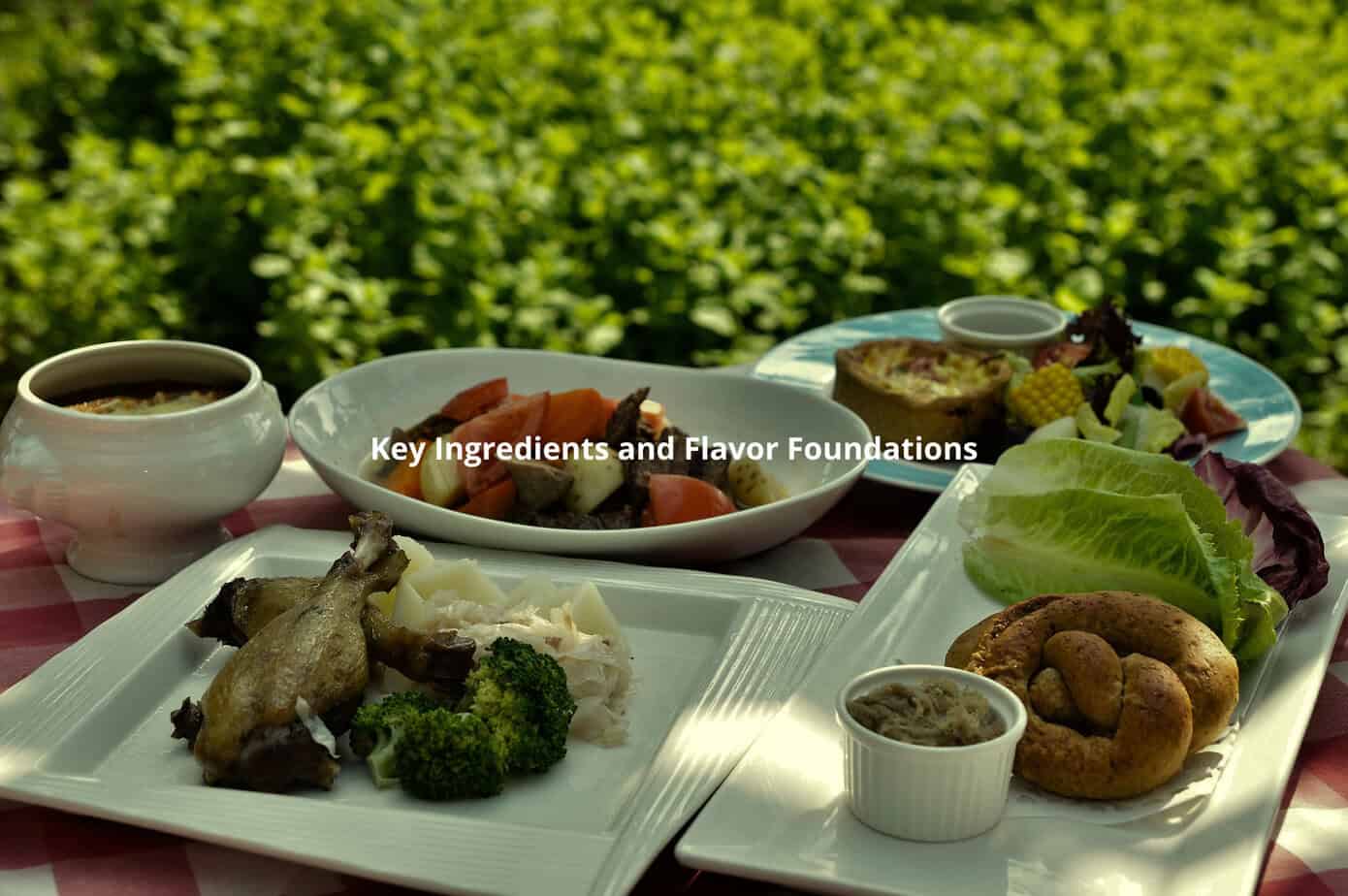Chicken sausage and shrimp stew is the perfect blend of smoky and tender. Start by browning smoked chicken sausage and fresh shrimp to lock in flavor. Sauté onion, celery, and bell pepper, the classic Cajun “holy trinity.” Use a roux for richness or a tomato base for a lighter touch. Simmer until everything melds beautifully, adding shrimp at the end to keep it juicy. Serve hot over rice or with crusty bread. This one-pot meal delivers bold, comforting Southern flavor without the fuss. Craving something hearty, spicy, and satisfying? Keep reading for the full recipe and tips!
Key Takeaways
- Brown the sausage and chicken first, this step builds a deep, savory base for your chicken sausage and shrimp stew.
- Add shrimp at the very end to avoid rubbery texture and keep the stew bright.
- You can swap proteins, veggies, and thickeners for nearly endless (and diet-friendly) variations.
Key Ingredients and Flavor Foundations

Strong flavors don’t just appear. They’re coaxed out, bit by bit, with every step. The first time I made chicken sausage and shrimp stew,
I thought dumping everything into the pot would be enough. It wasn’t. The difference comes from attention to the right proteins, vegetables, and the backbone, seasoning.
Proteins: Chicken Sausage and Shrimp Varieties
Protein is the heart of this stew. You’ll want a mix of smoky sausage and tender shrimp, with chicken to fill it out (1).
Sausage Options: Andouille, Chorizo, Turkey Kielbasa for Different Flavor Profiles
- Andouille: Classic Cajun, plenty of smoke, a little heat. This is where most Louisiana chicken sausage and shrimp stew recipes start.
- Chorizo: Spanish or Mexican chorizo adds a punchy spice and a little fat. Great for those who want a stew with bold color and earthy flavor.
- Turkey Kielbasa: Leaner and milder, but still gives you that snap and richness. For lighter or healthy chicken sausage and shrimp stew, this is a solid swap.
Chicken Cuts: Thighs for Richness, Breasts for Leaner Texture
- Thighs: Dark meat stays juicy, even after a long simmer. More flavor, too.
- Breasts: Use them if you want something leaner. They cook quickly, so watch the timing to avoid dryness.
Vegetables and Aromatics
The “holy trinity” of onion, celery, and bell pepper isn’t just tradition, it’s essential. That’s the base layer. Everything else builds on it.
Essential “Holy Trinity”: Onion, Celery, Bell Pepper
- Onion: Yellow or sweet onions, diced small.
- Celery: Adds a subtle, green bitterness.
- Bell Pepper: Red, green, or a mix. Sweeter peppers give more color.
Additional Veggies: Okra, Mushrooms, Garlic, Tomatoes for Complexity
- Okra: Classic for gumbo-style chicken sausage and shrimp stew. Thickens the broth and brings a gentle, grassy flavor.
- Mushrooms: For earthiness, shiitake or cremini work well.
- Garlic: Four to six cloves, minced.
- Tomatoes: Diced or crushed, or even tomato paste for a richer stew.
Liquids and Thickeners
You need enough liquid to simmer everything together, but the type and thickener shape the final texture.
Broth Choices: Chicken Broth, Seafood or Fish Broth, White Wine
- Chicken broth: The default. It’s reliable, especially if you make your own.
- Seafood or fish broth: Use this for a stew that leans toward the ocean.
- White wine: Dry, not sweet. Adds acidity and depth.
Thickening Agents: Roux for Traditional Gumbo Texture, Tomato Paste for Gluten-Free Options
- Roux: Equal parts flour and fat, cooked until golden or even dark brown. This is the backbone of a gumbo-style chicken sausage and shrimp stew.
- Tomato paste: If you’re skipping gluten, use this. It thickens and adds tang.
Seasonings and Spice Blends
This is where you set the mood for your stew. Spices and herbs aren’t just background, they’re front and center.
Classic Herbs and Spices: Oregano, Thyme, Bay Leaf, Basil, Paprika, Cumin
- Oregano and thyme: Earthy, a little floral. Use dried or fresh.
- Bay leaf: One or two is plenty.
- Basil: A handful of fresh leaves brightens things up.
- Paprika: Smoked or sweet, in generous spoonfuls.
- Cumin: Just a pinch, for warmth.
Cajun and Creole Seasoning Blends: Heat and Depth Enhancement
- Cajun seasoning: Usually a blend of paprika, cayenne, garlic powder, onion powder, and herbs.
- Creole seasoning: Similar, but sometimes milder, with more herbs.
Cooking Techniques and Step-by-Step Preparation
The best chicken sausage and shrimp stew is built step by step. Each layer adds something. The first time I tried a one-pot shortcut, the flavor was flat. Browning and patience make the difference (2).
Stovetop Method for Layered Flavor
Browning Sausage and Chicken to Develop Fond
- Slice sausage into coins, brown in a heavy Dutch oven with a little oil over medium heat. Don’t stir too much, you want a crust.
- Remove sausage, add chicken (cubed, skinless, boneless). Brown on all sides, then set aside with the sausage.
- Those browned bits stuck to the bottom? That’s the fondness. Don’t clean them out.
Sautéing Vegetables and Deglazing with Wine or Broth
- Add onions, celery, and bell pepper to the pot. Stir, scraping up the fond as the vegetables sweat.
- Add garlic, mushrooms, and okra if using. Sauté until soft.
- Pour in a good glug of white wine (about half a cup) or a cup of broth, scraping up the rest of the browned bits.
- Stir in tomatoes or tomato paste. Let it cook down for a few minutes.
Simmering and Timing Protein Addition
Cooking Chicken and Sausage before Adding Shrimp
- Return sausage and chicken to the pot with the vegetables.
- Add remaining broth (about 4 cups for a standard recipe serving 6).
- Toss in bay leaf, dried herbs, and a spoonful of Cajun seasoning.
- Bring to a boil, then lower to a simmer. Cook for 20–25 minutes, until chicken is tender and flavors deepen.
Adding Shrimp Last to Preserve Tenderness
- Add peeled and deveined shrimp, about one pound for six servings.
- Simmer gently for 4–5 minutes, until the shrimp are just pink and opaque. Overcooking will make them rubbery.
- Taste and adjust seasoning. More salt, hot sauce, or herbs as needed.
One-Pot and Rice-Based Variations
Combining Uncooked Rice with Proteins and Vegetables for Convenience
- For a chicken sausage shrimp and rice stew, add 1 cup uncooked rice after the vegetables and broth.
- Stir in proteins, cover, and simmer until the rice is tender (about 20 minutes).
- Add shrimp at the very end, cooking just until done.
Adjusting Liquid Ratios for Proper Rice Cooking
- Use 2 cups of broth for every cup of rice. Add more if using brown or wild rice.
Slow Cooker Adaptation
Preparing Roux and Vegetables before Slow Cooking
- Make a roux on the stove: ¼ cup flour and ¼ cup oil or butter, whisked and cooked until peanut butter colored.
- Add onions, celery, and bell pepper, cooking until soft.
- Transfer everything to the slow cooker.
Timing Shrimp Addition to Prevent Overcooking
- Add sausage, chicken, broth, and seasoning to the slow cooker. Cook on low for 4–6 hours.
- Shred or chop chicken if needed.
- Add shrimp in the last 15 minutes, just before serving.
How to Make Chicken Sausage and Shrimp Stew

Source: Glen And Friends Cooking
Customization and Dietary Considerations
Chicken sausage and shrimp stew is as flexible as you want it to be. The base recipe is just a start. Tweaks and swaps are almost expected in home kitchens.
Ingredient Swaps to Suit Preferences
Sausage Alternatives for Heat or Mildness
- Use chorizo for extra spice.
- Swap in turkey kielbasa or chicken apple sausage for a lighter, sweeter touch.
- For vegetarian versions, try plant-based sausage, though the texture and flavor will shift.
Vegetable Variations for Texture and Flavor Diversity
- Add more peppers for color.
- Stir in spinach or kale near the end for extra greens.
- Use sweet potatoes or carrots for sweetness and body.
Adjusting Spice Levels
Using Cayenne, Hot Sauce, or Milder Seasonings
- If you like it hot, add cayenne or red pepper flakes.
- Drizzle Crystal or Tabasco hot sauce before serving.
- For a milder stew, pull back on spice blends and add more fresh herbs.
Incorporating Fresh Herbs for Brightness
- Finish with a handful of parsley or green onions.
- Fresh thyme or oregano lifts the whole dish.
Gluten-Free and Health-Conscious Modifications
Omitting Roux and Using Tomato-Based Thickeners
- Skip the flour roux, use tomato paste and let the stew simmer longer to thicken naturally.
- Add okra for extra body and silkiness.
Choosing Leaner Proteins and Healthier Oils
- Use olive oil or avocado oil instead of butter or lard.
- Stick with chicken breasts, turkey sausage, and plenty of veggies.
Meal Prep and Freezer-Friendly Tips
Batch Cooking and Proper Storage Techniques
- Chicken sausage and shrimp stew keeps in the fridge for up to 3 days.
- For meal prep, portion out into containers and freeze for up to 2 months.
- Shrimp texture can suffer after freezing, so add fresh shrimp when reheating if possible.
Reheating Guidelines to Preserve Texture and Flavor
- Thaw overnight in the fridge.
- Reheat gently on the stove, adding a splash of broth if needed.
- Add a handful of fresh herbs or new shrimp just before serving.
Serving Suggestions and Popular Regional Variations
Serving isn’t just about filling the plate. It’s about matching the stew’s soul with the right side or topping.
Traditional Accompaniments
Serving Over White, Brown, or Wild Rice
- Classic is a mound of steamed white rice, soaks up the broth perfectly.
- Brown rice or wild rice for extra fiber and earthiness.
Pairing with Crusty Bread or Cornbread for Soaking Broth
- Thick slices of sourdough or a slab of cornbread. Dunking is half the fun.
Garnishes to Enhance Presentation and Flavor
Fresh Herbs: Parsley, Thyme, Oregano, Green Onions
- Scatter chopped parsley or green onions over the top.
- Fresh thyme or oregano leaves for a pop of color and aroma.
Additional Toppings: Grated Parmesan, Sliced Avocado, Hot Sauce Drizzles
- Grated parmesan adds richness.
- Avocado slices cool off a spicy stew.
- A swirl of hot sauce for those who want extra heat.
Regional Style Inspirations
Cajun and Creole Gumbo with Dark Roux and Okra
- Start with a dark, nutty roux. Add okra for a true chicken sausage and shrimp gumbo.
- Serve over rice, and don’t rush the simmer.
Tomato-Based Southern Stew Variants
- Use more tomatoes and skip the roux for a gluten-free, bright red stew.
- Mushrooms and extra peppers round out the flavors.
Creative Twists and Fusion Ideas
Incorporating Sofrito or Holy Trinity for Depth
- Sofrito (onion, garlic, peppers, tomato, and herbs sautéed together) brings a Cuban or Puerto Rican angle.
Adding Sun-Dried Tomatoes, Poblano Peppers, or Exotic Spices
- Sun-dried tomatoes for tang.
- Poblano or jalapeño for gentle heat.
- Try a pinch of smoked paprika or even a little curry powder for something different.
Conclusion
I still remember the first time I served chicken sausage and shrimp stew. The sausage sizzled, the shrimp popped, and the pot emptied fast. If you want a stew that’s soulful, simple, and weeknight-ready, start by browning your meats, sweating your aromatics, and adding shrimp last. Try new sausages, toss in fresh veggies, or switch the sides. This one-pot wonder adapts to you. Grab a pot, your next favorite meal is just a simmer away.
FAQ
Can I make a chicken sausage shrimp and rice stew in one pot?
Yes, you can easily turn your chicken sausage and shrimp stew into a chicken sausage shrimp and rice stew. Add uncooked rice with your proteins and veggies, then simmer until the rice is tender. Just make sure to adjust the broth so it doesn’t dry out, usually 2 cups of liquid for every cup of rice. Add shrimp at the very end so it stays tender and doesn’t overcook.
What’s the difference between Cajun chicken shrimp sausage stew and Creole versions?
Cajun chicken shrimp sausage stew usually starts with a dark roux and has bold heat from Cajun seasoning. It’s rustic and earthy. Creole chicken sausage shrimp stew often includes tomatoes and has more herbs, making it feel a little lighter and brighter. Both are rich and comforting, but their spice and ingredient balance set them apart.
How do I make a gluten-free chicken sausage and shrimp stew?
To make a gluten-free chicken sausage and shrimp stew, skip the roux and use tomato paste or diced tomatoes as a thickener. This creates a tomato-based chicken sausage shrimp stew that still feels rich. Add okra if you want that gumbo-style body. Use gluten-free sausage and double-check your broth ingredients to avoid hidden flour.
Can I freeze meal prep chicken sausage shrimp stew?
Yes, meal prep chicken sausage shrimp stew freezes well. Let it cool, then portion it out in airtight containers. For best texture, add fresh shrimp when reheating instead of freezing them. This makes it one of the easiest freezer meals for busy weeks. You can reheat on the stove and finish with herbs or lemon juice to freshen it up.
What’s the best way to serve Southern chicken sausage and shrimp stew?
Southern chicken sausage and shrimp stew is usually served over white rice or with crusty bread. You can also try brown or wild rice for more texture. Add sliced avocado, a dash of hot sauce, or sprinkle parmesan and green onions on top. These garnishes elevate the dish and make your bowl even more comforting and flavorful.
References
- https://www.nutritionix.com/food/louisiana-style-chicken-sausage-and-shrimp-skillet
- https://www.foodnetwork.com/recipes/bobby-flay/chicken-shrimp-sausage-stew-and-endive-salad-with-toasted-almond-vinaigrette-recipe-1950240
Related Articles
- https://milkwoodrestaurant.com/devein-shrimp/
- https://milkwoodrestaurant.com/what-can-i-make-with-chicken-sausage-links/
- https://milkwoodrestaurant.com/shrimps-vein/
Was this helpful?

I’m Mary R. Q. , a seasoned professional chef dedicated to elevating home cooking experiences. Through my expertise in the culinary arts, I provide practical cooking tips and insightful reviews of kitchen utensils on my blog, milkwoodrestaurant.com. As a passionate advocate for transforming everyday meals into extraordinary culinary adventures, I aim to empower home cooks with the knowledge and tools they need to create delicious and memorable dishes. I’m also an author of the book “1,001 Kitchen Tips & Tricks: Helpful Hints for Cooking, Baking, and Cleaning (1,001 Tips & Tricks)” which is sold on Amazon. Join me on a flavorful journey as we explore the art of cooking and the essential tools that make it a joy.








